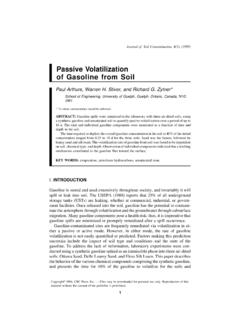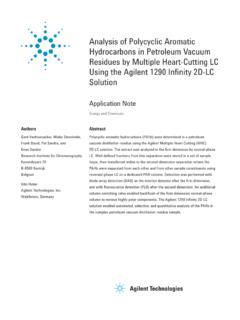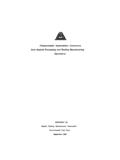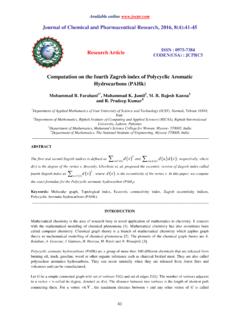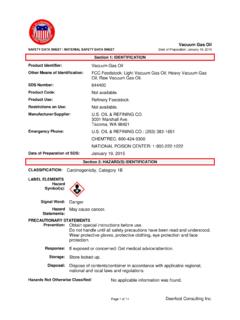Transcription of Background Levels of Polycyclic Aromatic Hydrocarbons …
1 1 Copyright 1996, CRC Press, Inc. Files may be downloaded for personal use only. Reproduction of thismaterial without the consent of the publisher is of Soil Contamination, 3(4): (1994) Background Levels ofPolycyclic AromaticHydrocarbons (PAH) and SelectedMetals in New England Urban SoilsL. J. N. Bradley,1* B. H. Magee,2 and S. L. Allen11 ENSR Consulting and Engineering, 35 Nagog Park, Acton, MA 017202 Ogden Environmental and Energy Services, 239 Littleton Road, Suite 7C,Westford, MA 01886* To whom all correspondence should be : Polycyclic Aromatic Hydrocarbons (PAH) are byproducts of combustion and areubiquitous in the urban environment.
2 They are also present in industrial chemical wastes, suchas coal tar, petroleum refinery sludges, waste oils and fuels, and wood-treating residues. Thus,PAHs are chemicals of concern at many waste sites. Risk assessment methods will yield risk-based cleanup Levels for PAHs that range from to mg/kg. Given their universal presencein the urban environment, it is important to compare risk-based cleanup Levels with typical urbanbackground Levels before utilizing unrealistically low cleanup targets. However, little data existon PAH Levels in urban, nonindustrial soils. In this study, 60 samples of surficial soils from urbanlocations in three New England cities were analyzed for PAH compounds.
3 In addition, allsamples were analyzed for total petroleum Hydrocarbons (TPH) and seven metals. The upper95% confidence interval on the mean was 3 mg/kg for benzo(a)pyrene toxic equivalents,12 mg/kg for total potentially carcinogenic PAH, and 25 mg/kg for total PAH. The upper 95%confidence interval was 373 mg/kg for TPH, which exceeds the target level of 100 mg/kg usedby many state regulatory agencies. Metal concentrations were similar to published backgroundlevels for all metals except lead. The upper 95% confidence interval for lead was 737 mg/kg inBoston, 463 mg/kg in Providence, and 378 mg/kg in WORDS: Background , PAH, metals, urban, anthropogenic, INTRODUCTIONP olycyclic Aromatic Hydrocarbons (PAHs) are byproducts of combustion and arenaturally occurring chemicals in the environment.
4 Forest fires and volcanoes aremajor natural sources of PAHs, but there are anthropogenic sources as well due toburning of fossil fuels, including automobile and industrial emissions. PAHs arechemicals of concern in many waste site investigations that are undertaken pursu-ant to the Comprehensive Environmental Response, Compensation, and LiabilityAct (CERCLA), the Resource Conservation and Recovery Act (RCRA), and state2 Copyright 1996, CRC Press, Inc. Files may be downloaded for personal use only. Reproduction of thismaterial without the consent of the publisher is waste programs. Risk assessments performed according to federal guid-ance for former manufactured gas plant sites, wood treating facilities, petroleumrefineries, and other sites generally conclude that PAHs pose unreasonable risks tohuman health and that remedial actions must be taken to reduce risks to acceptablelevels.
5 The majority of the risk posed by PAHs is generally due to benzo(a)pyreneand the other PAHs that have been shown to cause cancer in laboratory animalsafter repeated dosings. The EPA (1993a) currently identifies seven PAHs as probable human (B2) carcinogens : benzo(a)pyrene, benzo(a)anthracene,benzo(b)fluoranthene, benzo(k)fluoranthene, chrysene, dibenz(a,h)anthracene, andindeno(1,2,3-c,d) of the very health-protective assumptions used in regulatory risk as-sessments, very low risk-based clean-up Levels for PAHs are derived for such Michigan, residential soil cleanup Levels of mg/kg for each carcinogenicPAH have been set (MDNR, 1993).
6 In New Jersey, proposed residential soil clean-up Levels are mg/kg for benzo(a)pyrene (New Jersey Register, 1992). The useof standard CERCLA risk assessment guidance ( EPA, 1993b) results in thederivation of a risk-based cleanup level for benzo(a)pyrene of of these risk-based soil cleanup Levels are below the urban, nonindustrialbackground soil concentrations presently reported in the literature. However, theavailability of such data is very limited. Blumer (1961) reports that benzo(a)pyreneconcentrations in Cape Cod, MA, soils range from to mg/kg. Menzie etal. (1992) report that urban Background soil Levels of total carcinogenic PAH rangefrom to mg/kg.
7 Butler et al. (1984) report that total PAH Levels in soilsalongside roadways in England range from 4 to 20 mg/kg, and potentially carci-nogenic PAH range from to mg/kg. Blumer et al. (1977) report that totalPAH Levels in soils in a Swiss town range from 6 to 300 is very difficult to compare the data from these studies to the results of siterisk assessments due to the limited dataset and the nonuniformity of the PAHcompounds evaluated. Clearly, more data are required from nonindustrial urbanlocations to define the urban Background level for PAH and to critically evaluatethe role of risk assessment in setting remedial goals for PAH in soils.
8 Accordingly,we have collected 60 samples of surficial soils from urban locations in three NewEngland cities and analyzed them for all 17 PAH compounds present on the EPA sTarget Compound List, which is used in the Superfund program. In addition, allsamples were analyzed for total petroleum Hydrocarbons (TPH) and for sevenmetals: arsenic, barium, cadmium, chromium, lead, mercury, and METHODSA. Sample CollectionSamples of surficial soils from urban locations in three New England cities werecollected: Boston, MA; Providence, RI; and Springfield, MA. Twenty independent3 Copyright 1996, CRC Press, Inc.
9 Files may be downloaded for personal use only. Reproduction of thismaterial without the consent of the publisher is and duplicates of two samples were collected in each city. The sampleswere collected on July 21, 22, and 23, 1992, respectively. The samples were takenat a depth of 0 to 6 in. in areas considered to be not directly affected by industrialsites. Generally, the locations were along roads and sidewalks, and in parks andopen lots. Each location was characterized in writing, including a soil description,and photographically documented. The samples were collected following standardenvironmental sampling protocols ( EPA, 1986).
10 B. Sample AnalysisChemical analysis of the samples was performed by AnalytiKEM, Inc. (CherryHill, NJ). The samples were analyzed by GC-MS for the 17 PAH compoundspresent on the EPA s Target Compound List using the methods required by EPAM ethod 8270 for the analysis of semivolatile compounds. In addition, the sampleswere analyzed for the eight RCRA metals, total petroleum Hydrocarbons (TPH;EPA Method ), and total solids. The complete analyte list is given inTable Data ValidationValidation of the data received from AnalytiKEM was performed according EPA (1991) guidelines.

